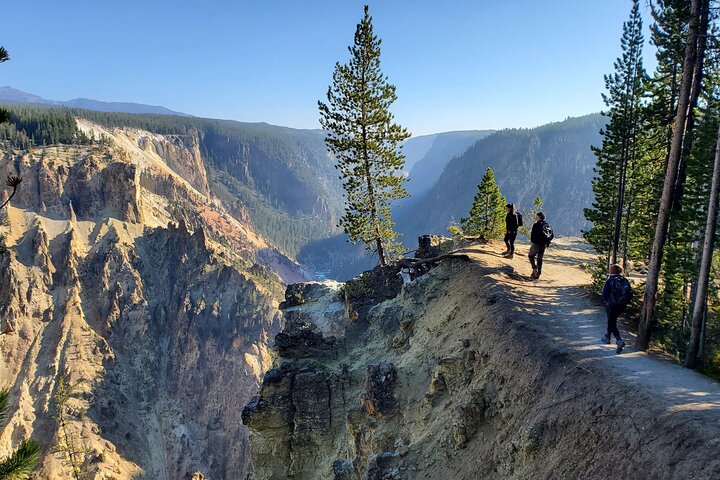Walking the Edge: A Guided Loop Around the Grand Canyon of the Yellowstone
A six-hour guided loop that pairs geology, wildlife glimpses, and lunch with canyon views
The canyon opens before you like an honest wound in the earth: jagged walls of pumice and rhyolite banded in ochre, rust and lemon, steam ghosting from distant hydrothermal seams. Your guide sets a steady pace on the rim trail, voice low and matter-of-fact, pointing out the thinning aspens and a sweep of river that has, over millennia, dared the rock to keep its colors. The river won. You keep walking.
Trail Wisdom
Start Early
Begin at first light to avoid crowds at key viewpoints like Artist Point and to catch wildlife during their active morning window.
Layer for Altitude
Temperatures swing—wear breathable base layers, an insulating midlayer, and a packable shell for wind or rain.
Carry 2–3L Water
Altitude and dry air increase dehydration; bring enough water and a method to treat refills if needed.
Respect Wildlife Distances
Guides will advise on safe viewing; never approach bears or elk—use binoculars and obey park rules.
Local Knowledge
Hidden Gems
- •A quieter overlook near Uncle Tom’s Trail trailhead for fewer crowds
- •Short detour to a nearby meadow for wildflower spotting in late spring
Wildlife
Elk, Marmot
Conservation Note
Stay on designated trails to protect fragile geothermal features and keep to group sizes and distances recommended by the park to reduce wildlife disturbance.
The Grand Canyon of the Yellowstone was documented by 19th-century expeditions and became a key feature in the park established in 1872.
Seasonal Guide
spring
Best for: Wildflowers, Fewer visitors, Melting waterfalls
Challenges: Residual snow on some higher trails, Variable trail conditions, Cold mornings
Late spring brings brisk mornings, high water flow in the river, and early wildflowers—expect cooler temps and spotty snow patches.
summer
Best for: Stable trail conditions, Full ranger and visitor services, Warm midday temps
Challenges: Higher crowds, Afternoon thunderstorms, Strong sun exposure
Summer is the most dependable time for clear trails and full park services, but go early to avoid crowds and afternoon storms.
fall
Best for: Crisp air and fewer crowds, Golden aspen displays, Clear visibility
Challenges: Shorter daylight, Early snow possible, Cooler temperatures
Early fall offers cooler hiking with vivid aspens and thinning crowds; watch for sudden weather shifts as winter approaches.
winter
Best for: Snow and solitude (not for this tour), Cross-country skiing and snowshoeing nearby
Challenges: Trail closures and deep snow, Limited services, Severe cold
Winter brings deep snow and closed roads in parts—this guided loop is not typically offered in winter months due to access and safety.
Photographer's Notes
What to Bring
Sturdy Hiking BootsEssential
Support and traction for uneven rim and forest trails.
Water Reservoir or Bottles (2–3L)Essential
Hydration for a six‑hour day at altitude.
Lightweight Rain ShellEssential
Wind and afternoon storms can arrive quickly; stay dry and warm.
Binoculars or 70–200mm Lens
Helps with wildlife viewing and compressing canyon views into powerful photos.
Common Questions
How long is the hike and how difficult is it?
The guided loop runs about 6 hours and covers roughly 6 miles with moderate climbs—suitable for hikers comfortable on uneven terrain.
Are bears a concern on this hike?
Yes—bears and other wildlife are present; guides monitor animal activity, carry bear spray as required, and enforce safe viewing distances.
Is the hike suitable for children?
Older, active children who can handle several miles and follow group safety rules will do fine; younger kids may find the length challenging.
What is included in the tour price?
This experience typically includes a guided hike, interpretive guidance, and a boxed lunch; confirm specifics on the booking page.
Do I need permits or park passes?
Yellowstone entrance fees apply—your guide or operator may include these or advise you to bring a valid park pass; check your booking details.
Can I cancel or change my booking?
This product lists free cancellation and instant confirmation—review the operator’s specific cancellation window and policies at booking.
What to Pack
Sturdy boots for traction; 2–3L water to stay hydrated at altitude; windproof rain shell for sudden storms; layered clothing for temperature shifts
Did You Know
The Grand Canyon of the Yellowstone is roughly 20 miles long and up to about 1,200 feet deep in places—its vivid colors result from hydrothermal alteration of the volcanic rock.
Quick Travel Tips
1) Arrive before 8 a.m. to avoid peak crowds; 2) Carry your park pass or purchase at the entrance; 3) Expect limited cell service in the canyon area; 4) Keep food sealed to avoid attracting wildlife
Local Flavor
After the hike, head to Canyon Village for a hearty meal at the Canyon Lodge Dining Room or grab coffee and a packed sandwich at the general store; for dining outside the park, Gardiner and West Yellowstone both offer casual taverns and local brews to compare notes on the day’s sightings.
Logistics Snapshot
Closest airport: Bozeman Yellowstone International (BZN) or Jackson Hole (JAC); Driving distance to trailhead: 1–2 hours depending on entry point; Cell service: intermittent; Permits/passes: Yellowstone entrance fee required
Sustainability Note
This canyon’s geothermal features are fragile—stay on boardwalks and trails, pack out all trash, and avoid introducing soaps or food into waterways.
